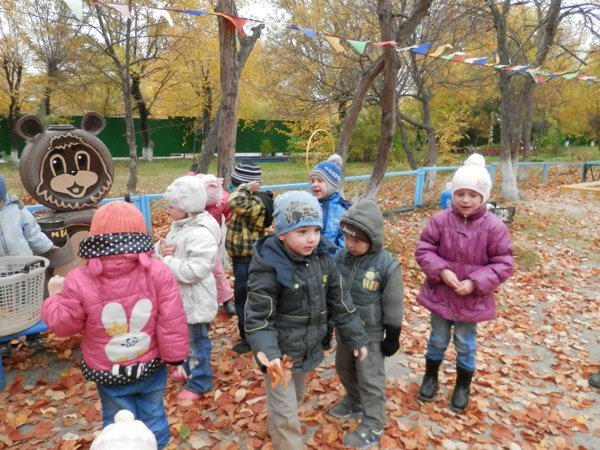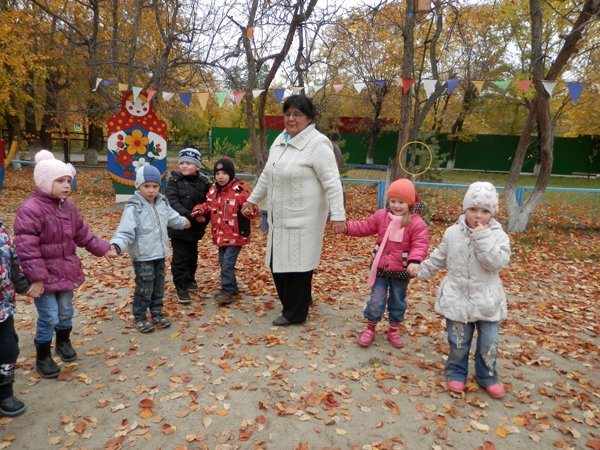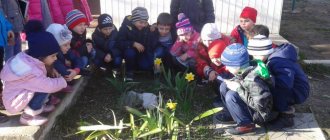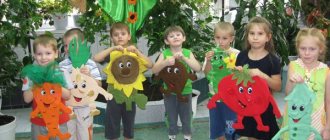Walk for children of the middle group “Autumn time”
Authors:
Milnichenko Tatyana Vasilievna,
Muslimova Liliya Rubilevna
educators
MADOU d/s No. 133, Tyumen
Target:
Summarize the signs of Autumn with your children. To foster cognitive interest in nature, to develop speech development in children. The desire to be in the fresh air, to learn to notice the beauty of nature. Loving her, trying to protect her from trash, learning to take care of her.
Objectives: - Help consolidate knowledge about trees, learn to identify trees by their characteristics, learn to distinguish the leaves of different trees; - Develop children's speech. — Enrich your vocabulary. - Train memory and attention. — Form a holistic picture of the natural world. — Foster concern for the environment.
Preliminary work:
Observing autumn nature, looking at trees, learning poems about autumn, reading works of art. Examination of a reproduction of Levitan’s painting “Golden Autumn”, as well as sketches and illustrations depicting various trees in autumn, collecting leaves on a walk.
Progress of the walk
If the leaves on the trees have turned yellow, If the birds have flown to a distant land, If the sky is gloomy, if the rain is pouring, This time of year is called autumn. Author: M. Khodyakova.
Observation:
Remind children that autumn has come. The whole ground was covered with leaves - everything around was yellow. That's why autumn is called yellow and golden. Draw the children's attention to how one leaf flies to the ground, the other spins, spins and slowly falls to the ground. Clarify that the leaves are light, so they fly to the ground slowly. The wind blew, and many leaves rustled to the ground - this is leaf fall.
Look at the leaves of different trees. Please note that the surface of the leaf blade varies from tree to tree.
Outdoor game "Falling Leaves"
The goal is to consolidate children’s knowledge about the color and size of autumn leaves. Reinforce the concept of “leaf fall.” Progress of the game. Children choose a leaf for themselves and name which leaf they chose based on size and color. Children run and wave their arms:
Leaf fall! Leaf fall! Yellow leaves are flying. (children with yellow leaves)
Leaf fall! Leaf fall! Red leaves are flying! (children with red leaves)
Beautiful yellow leaves are spinning! (children with yellow leaves)
Beautiful red leaves are spinning! (children with red leaves)
They sat down, sat down and froze.
A light breeze came and blew.
Leaves rose and scattered in different directions.
Spinning, spinning.
Leaf fall, leaf fall! Leaves are flying in the wind!
Outdoor game “ Run to the named tree.”
Goal: to train in quickly finding the named tree.
Progress of the game: The driver is selected. He names a tree, all children must listen carefully to which tree is named and, in accordance with this, run from one tree to another. The driver carefully monitors the children; whoever runs to the wrong tree leaves the game.

Sedentary game "Leaves"
Leaves are falling, falling - (Children are spinning, raising their arms up, squatting)
It's leaf fall in our garden. Yellow, red leaves (Spin again)
They curl and fly in the wind. Birds are flying south - (Running in a circle, waving their arms)
Geese, rooks, cranes. Now the last flock is flapping its wings in the distance.

Guys, let's collect colorful leaves to make a beautiful panel out of them to decorate the group. (Children and their teachers collect leaves, discussing their color, shape and from which tree they fell).
Educator: Guys, what beautiful leaves you have. You liked the walk, you would like to come here again (children's answers). Unfortunately, it's time for us to go, well done to you all!
List of used literature:
1. Teplyuk S.N. Walking exercises in the middle group. For working with children 3-4 years old. M.: -Mosaika-Sintez, 2010
2. Ulanova L.A., Jordan S.O. Methodological recommendations for organizing and conducting walks for children 3-7 years old. – SPb.: “CHILDHOOD-PRESS”, 2008
3. Author: M. Khodyakova poem “Autumn Leaves”
We invite teachers of preschool education in the Tyumen region, Yamal-Nenets Autonomous Okrug and Khanty-Mansi Autonomous Okrug-Yugra to publish their teaching materials: - Pedagogical experience, original programs, teaching aids, presentations for classes, electronic games; — Personally developed notes and scenarios of educational activities, projects, master classes (including videos), forms of work with families and teachers.
Why is it profitable to publish with us?
1. “Kindergartens of the Tyumen Region” is an officially registered specialized media outlet at the federal level. 2. The activities of the editorial office are supported by the Department of Education and Science of the Tyumen Region 3. We issue a “Certificate of Publication” in the media. 4. The document has a unique number, is entered in the register, has the original seal of the editorial office of the online publication and signature. 5. “Certificate of publication” in the media is sent to the author in both paper and electronic versions.
Details >>>
Sample “Certificate of publication of author’s methodological material in the media.”pdf
Share
Card index of walks in the middle group for October
October
Walk 1
Observing insects in the fall - teaches you to find and name insects: ant, fly.
Labor activity: collecting toys in the sandbox.
The outdoor game “Run Quietly” - teach how to move silently.
Didactic game “What insects can do” - enrich children’s knowledge, teach children to express their thoughts, develop memory and coherent speech.
Individual work on physical education: walk along the leaves, clearly stepping on the laid path.
Walk 2
Observing sand introduces children to the characteristics of sand, develops curiosity and memory.
Labor activity: collecting garbage in the sandbox - instilling hard work, teaching how to work together.
Outdoor game “Bubble” - teach children to stand in a circle, make it wider, then narrower; learn to coordinate your movements with the spoken words.
Didactic game “What will I build from sand” - to teach children to compose simple sentences on a given topic.
Individual work on physical education: jumping on two legs around the sandbox.
Walk 3
Observation of the birch tree - continues to introduce the birch tree, highlighting characteristic features and changes associated with the time of year; fosters a caring attitude towards wood as a living object of nature.
Labor activity : cleaning the territory - teach to work together, to achieve the completion of a task through joint efforts.
The outdoor game “Find Yourself a Pair” is to teach you how to choose different pairs based on a signal.
Didactic game “Where can I buy this?” − Strengthen children’s knowledge that different products are sold in different stores; teach children to distinguish stores according to their purpose and navigate their surroundings.
Individual work : game exercise “From bump to bump” - practice jumping on two legs.
Walk 4
Observing fading flowers teaches you to notice changes in inanimate nature that occur on earth; activates children's vocabulary.
Labor activity : collecting dry grass in the flower garden - teaching children to work, helping adults in cleaning the area.
Outdoor game “Hares and Wolves” - practice running and jumping.
Didactic game “Lay out a pattern” - learn to lay out a pattern from pebbles, blades of grass, maple seeds; develop imagination.
Individual work on physical education: rolling a ball to each other while sitting on their heels.
Walk 5
Observing the weather - teaches you to pay attention to how the weather has changed, teaches you to compare natural changes, and develops observation skills.
Labor activity : cleaning autumn leaves - to cultivate the ability to work.
The outdoor game “Catch up” is to teach how to quickly act on a signal, and to cultivate friendly relations.
Didactic game “Compliment” - develop communication skills.
Individual work : game exercise “Catch up with me” - teach how to run in the right direction.
Walk 6
Observing the state of the weather - consolidates knowledge about the natural phenomenon - fog, teaches observation of natural phenomena.
Labor activity : sweeping the gazebo with a broom - to cultivate the desire to work together.
Outdoor game “Who is faster?” − improve the ability to run, climb, jump, and develop reactions.
Didactic game “Name it affectionately” - to cultivate a friendly attitude of children towards each other.
Individual work: game exercise “Depict the mood” - teach plastic movements to convey internal sensations.
Walk 7
Observing the soil - develops the ability for purposeful observation, teaches children to see the dependence of the state of the soil on nature.
Labor activity: cutting dry flower leaves, grass in flower beds - instilling a desire to work.
The outdoor game “Planes” is to teach children to run in different directions without bumping into each other, to teach them to listen carefully to the signal and start moving according to a verbal signal.
Didactic game: “Guess who called?” − teach to recognize children by their voices, call them by name.
Individual work on physical education: “Jump over the stream” (through a cord, a rail)
Walk 8
Observing migratory birds expands the understanding of migratory birds and the changes in the lives of birds in the fall, when cold weather sets in.
Labor activity : collecting toys in the sandbox - teaching order to the area.
The outdoor game “Dog and Sparrow” is to consolidate knowledge about the characteristic movements of birds and teach them to imitate their voice.
Didactic game “Magic Wand” - continue to cultivate the ability to be affectionate.
Individual work: an exercise to develop basic movements - to consolidate the ability to throw the ball to each other from below.
Walk 9
Observing autumn work in the garden consolidates knowledge about seasonal changes in nature.
Labor activity: sweeping paths from leaves.
The outdoor game “Find Where It’s Hidden” - to teach how to navigate in space.
Didactic game “Find the mistake” - teach to clearly pronounce polysyllabic words loudly, develop auditory attention.
Individual work: exercise to develop basic movements - improve technique, running.
Walk 10
Observing sparrows expands knowledge about the appearance and habits of a sparrow, develops attention and observation.
Labor activity: collecting sand in a sandbox - instilling a love of work in the team.
Didactic game “Define words” - activation of vocabulary, development of coherent speech, attention and thinking.
Outdoor game “Hares and wolves” - practice running and jumping.
Individual work : game exercise “Who will throw further?” − strengthen the ability to throw an object at a distance.
Walk 10
Observing the rowan continues to introduce the rowan, its structure, and allows you to examine its bright outfit.
Labor activity: collecting large garbage on the site, sweeping paths - to develop the ability to work in a subgroup.
The outdoor game “Shaggy Dog” - teach how to run around the entire playground, following commands at the teacher’s signal.
Didactic game “Say the opposite” - developing the ability to select words that have opposite meanings.
Individual work: game exercises “Throw further!”, “Who can reach the flag faster” - teach how to perform exercises with the ball; develop eye and running speed.
Walk 11
watching - teaches you to find differences in the appearance of different birds, paying attention to size and methods of movement.
Labor activity: raking dry leaves into piles - teaching to work in a team, providing assistance to adults.
The outdoor game “Migration of Birds” is to develop attention and dexterity.
Individual work: exercise to develop basic movements - developing the ability to roll hoops to each other.
Walk 12
Observing a magpie - forms an idea of the appearance of a magpie, its characteristic features, habits; foster the need to care for migratory birds.
Labor activity: collecting autumn leaves - learning to independently carry out basic tasks.
Outdoor game “Catch the ball” - learn to catch the ball with both hands.
Didactic game “Who eats what?” − consolidate knowledge about domestic animals.
Individual work: exercise to develop basic movements - learn to maintain balance while standing on one leg, hands on your belt.
Walk 13
Watching a cat expands your understanding of a pet and fosters a desire to take care of animals.
Labor activity : collecting toys in the sandbox.
Outdoor game “Mice and Cat” - to teach children to run easily, on their toes, without bumping into each other; navigate in space according to the teacher’s signal.
Didactic game “Bird and Cat” - teach how to move in a loose direction without bumping into each other.
Individual work: finger gymnastics “On a walk”.
Walk 14
Observing transport - teaches you to distinguish transport by appearance.
Labor activity: sweeping the gazebo - teach how to use brooms correctly.
The outdoor game “Cars” is to teach children to follow traffic rules and consolidate knowledge about trucks.
Didactic game “The Fourth Extra” - development of attention, intelligence, thinking.
Individual work : ophthalmological gymnastics “One - left, two - right...”.
Walk 15
Observing the work of a driver introduces them to the work of a driver and fosters a positive attitude towards the work of adults.
Labor activity: sweeping paths on the site with brooms - teach how to use brooms correctly, finish what you start.
Outdoor game: “Rabbits” - develop dexterity; learn to navigate in space.
Didactic game “Shop” − Development of coherent speech, resourcefulness; consolidation of knowledge about the rules of behavior in the store.
Individual work: exercise with a ball - rolling and hitting objects.
Walk 16
Observing a tit - introduces the tit, its habits, habitat, and appearance features.
Labor activity : collecting toys in the sandbox.
The outdoor game “Sparrows and a Car” is to train children in correct sound pronunciation and develop a reaction to a verbal signal.
Didactic game “What is it made of?” − developing the ability to compare and group objects; activation of the dictionary; development of attention and speech.
Individual work: game exercise “On a Level Path” - teach how to maintain balance.
Walk 17
Air transport surveillance
Labor activity : collecting small garbage in the sandbox.
The outdoor game “Planes” is to teach children to run in different directions without bumping into each other, to teach them to listen carefully to the signal and to start moving according to a verbal signal.
Didactic game “Doll Housewarming” - fostering a friendly attitude towards the new doll; consolidating children's knowledge about clothes, shoes, dishes, toys; development of coherent speech.
Individual work: finger gymnastics “On a walk”.
Walk 18
Observation - Continues to improve skills in determining the presence and direction of wind.
Labor activity: collecting toys in the sandbox.
Outdoor game “Snowballs and the Wind” - develop motor skills.
Didactic game “Name it in one word” - developing the ability to denote objects in one word, enriching vocabulary.
Individual work : game exercise “These are how fast your legs are” - running on your toes, with long steps.
Walk 19
Observing bullfinches expands knowledge and ideas about the appearance and habits of bullfinches.
Labor activity: sweeping in the gazebo.
The outdoor game “The Dog and the Sparrows” is to consolidate knowledge about the characteristic movements of birds and imitate their voices.
Didactic game “What has changed?” − development of attention, coherent speech, and the ability to describe objects.
Individual work: game exercise “Little bunnies jumping on the lawn” - jumping on two legs and moving forward.
Walk 20
Observing the flora in autumn introduces one to the structure of a tree and fosters a caring attitude towards nature.
Labor activity: collecting fallen leaves around trees - encourage them to independently carry out basic tasks.
Outdoor game “On a level path” - develop coordination of hand movements; develop a sense of balance and orientation in space.
Didactic game “Who talks like this?” − expansion of vocabulary, development of reaction speed.
Individual work: exercise with the ball - hitting the ground with two hands, one hand (right and left) at least 5 times in a row.
Walk 21
Observing the wind - consolidates children's knowledge about the wind, teaches them to determine the strength of the wind.
Labor activity : collecting garbage in the sandbox - instilling in children a desire to learn and respect the work of a janitor.
The outdoor game “Hen and Chicks” is to teach children to follow the rules of the game.
Didactic game “Find such a leaf” - teach children to find a leaf based on a model, fix the name of a color or tree.
Individual work on physical education: jumping into and out of a circle made of autumn leaves.
Walk 22
Observing a pedestrian - introduces children to the pedestrian road, teaches them to cross the road correctly and follow traffic rules.
Labor activity : sweeping in the gazebo.
The outdoor game “Train” teaches children to walk and run after each other in small groups; teach to start moving and stop at a signal.
Didactic game “Remember, repeat” - teach children to memorize 4-5 words, develop auditory memory.
Individual work on physical education: jump to a leaf (jumping height).

